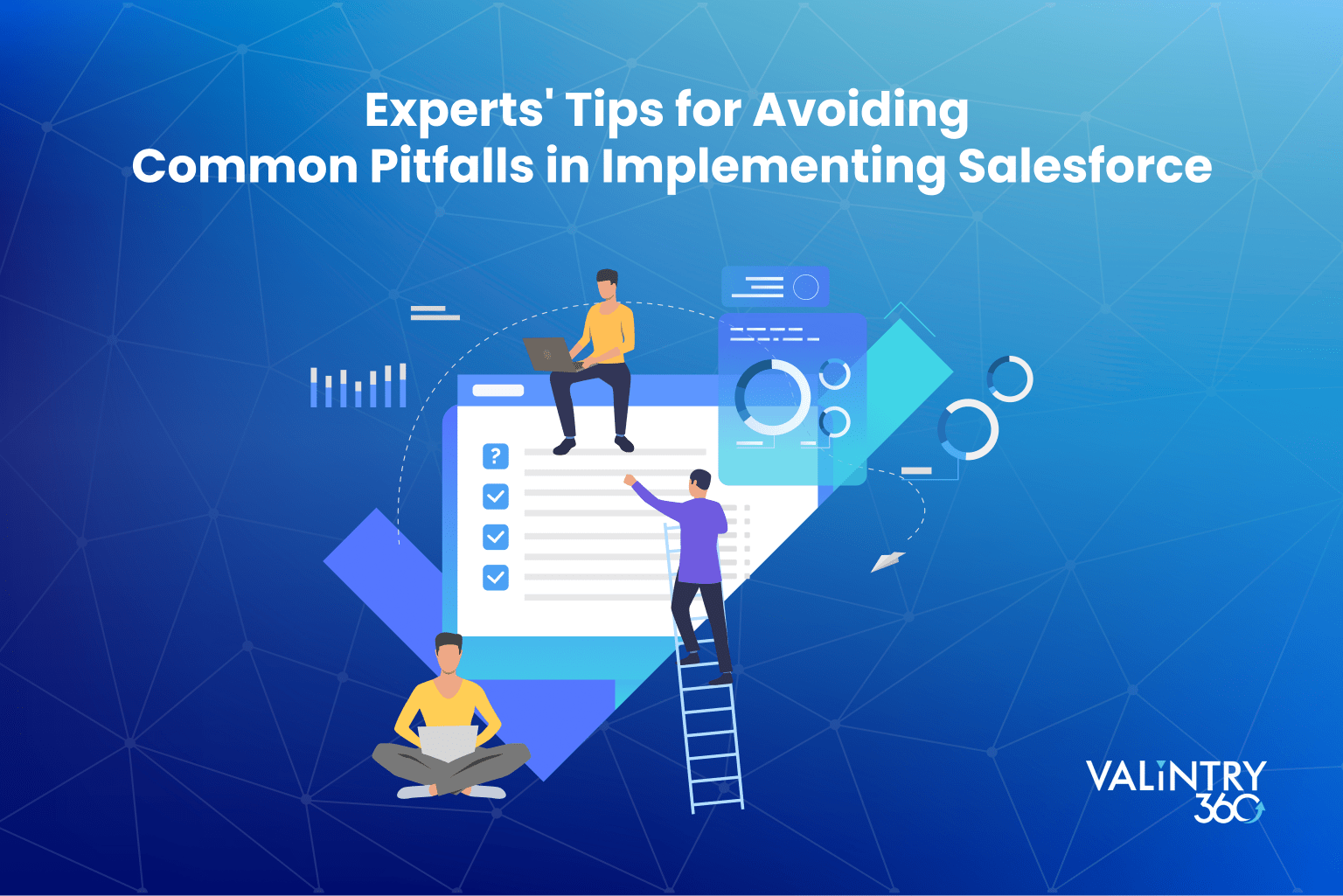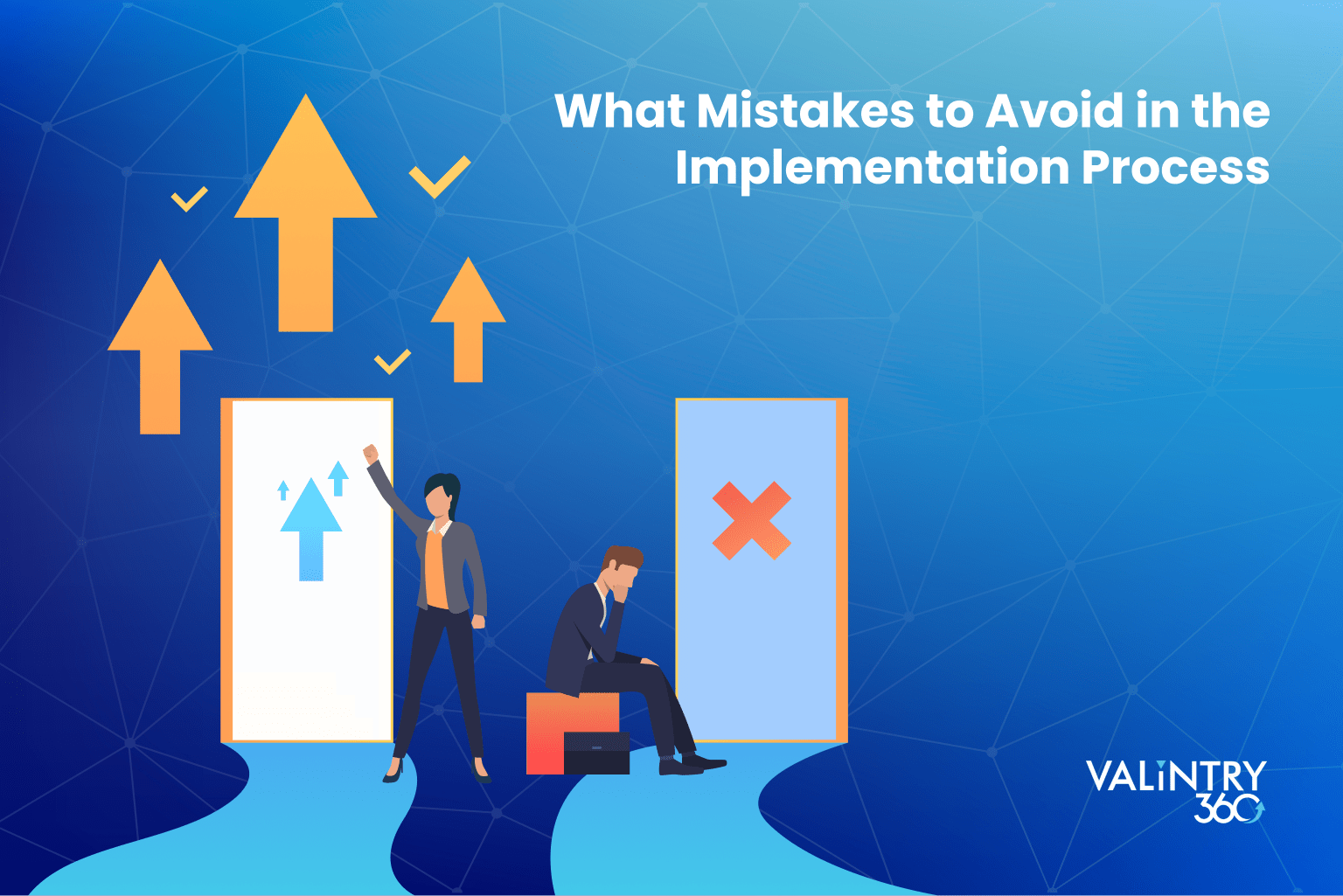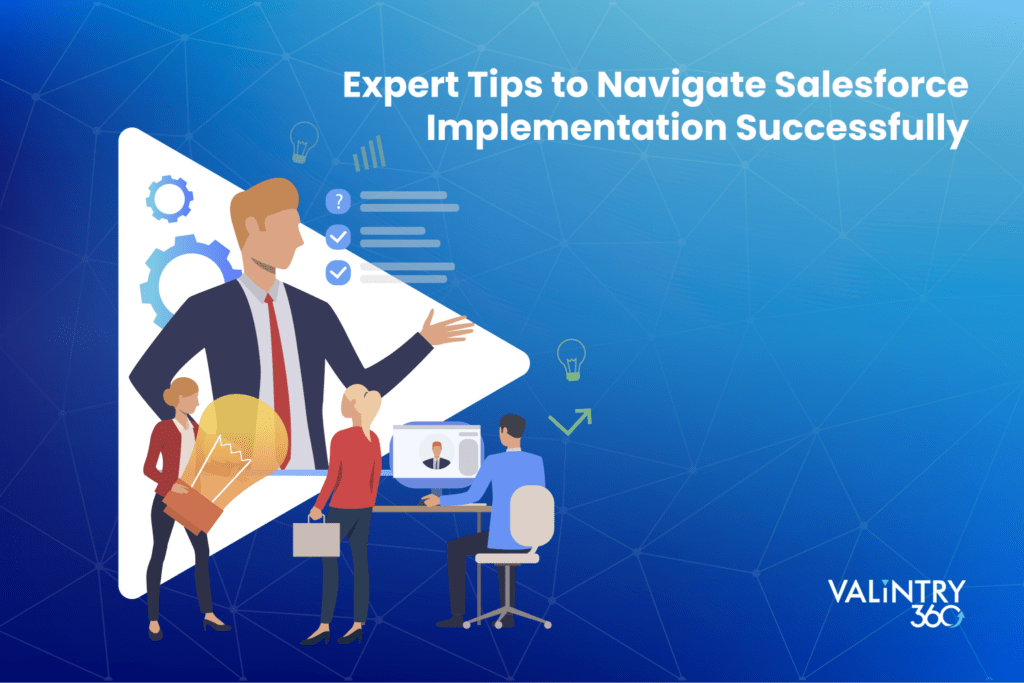
- Salesforce Implementation Services
Understanding the Essentials of a Salesforce Implementation
Salesforce Implementation Services present a powerful tool that can help transform the way your organization manages customer data and interactions. However, a successful Salesforce implementation solution requires careful planning and execution to avoid common pitfalls that can hinder your progress in achieving all that Salesforce is capable of providing you or organization. At VALiNTRY360, we’ll explain all the essential steps necessary to configure a solution that will ensure a smooth Salesforce implementation and most importantly workforce adoption.
1. Define Clear Objectives and Scope
Before diving into a Salesforce implementation, it’s crucial to define clear objectives and scope for your project. What specific goals are you aiming to achieve with Salesforce? Are you looking to streamline patient care, improve sales processes, enhance customer service, or streamline marketing efforts? Further, is there a documented understanding your objectives that will guide the customization and configuration of your Salesforce instance to align with your unique business needs.
Define the business processes you want Salesforce to help digitally transform. Are those processes documented and does everyone within a specific function operate with the same procedures and process? If not, business process mapping is a key first step to a successful Salesforce implementation. Salesforce can be configured to support almost any healthcare, sales, marketing, or customer service process as long as it is defined first.
Equally important is to define which Salesforce features and functionalities you will leverage to support your business process and how they will be integrated into your existing workflows. Having a well-defined functionality scope helps prevent scope creep, (increased costs) and keeps the project on track, on time and on budget.
2. Choose the Right Cloud and the Right Edition
Salesforce offers various cloud and edition solutions, each tailored to different business needs and sizes. Selecting the right solution is critical to achieve the most cost effective and successful implementation of a Salesforce Cloud service. Consider factors such as the type of product your company provides, consider the size of your organization, consider the complexity of your processes, and your budget. Common editions include Salesforce Essentials, Professional, Enterprise, and Unlimited. Each of these levels forces limits on the scope of features and functionality along with volumes of transactions that can be delivered.
Take time to assess your requirements and the timing of when you will need the software available to users. Consult with a Salesforce Partner like VALiNTRY360 to help make an informed decision before you start buying Salesforce licenses.
3. Data Migration Planning
Migrating existing data into Salesforce is a fundamental part of almost every implementation for a going concern. Data quality and accuracy are paramount to ensure the CRM functions effectively. Data migration can be the most complex part of an implementation as no two systems are the same and matching up the data between the system can be a large effort. Think about what is absolutely needed to support the system going forward and plan to move only what is important.
Create a comprehensive data migration plan that includes data extraction from the existing source, cleaning out duplicate data or out of date data and ensure all of the necessary information to be transferred is identified and accurate. Data transformation is equally important so ensure that information which my change due to changes in the business process are thought through thoroughly for a successful transformation.
Most comprehensive data migration plans are often referred to as an ETL (extract, transfer and load) process. Identify all the data sources you will be drawing data from, map the specific required data fields, and establish data validation processes to minimize errors and the loading of bad data during the migration. With VALiNTRY360’s efficient Salesforce Implementation Services, these actions can be conducted effectively and will serve as an important foundational process in making a successful Salesforce launch and most importantly user adoption once the system goes live.
What Mistakes to Avoid in the Implementation Process?

Salesforce has the potential to revolutionize how your business manages patient/customer relationships and the automation of your business processes to drive efficiency and much more. Many organizations encounter challenges during the implementation process that can delay the time it takes to fully implement the Salesforce solution and the positive effect it can have on your business. Let’s take a look at potential critical mistakes that you can avoid when implementing Salesforce:
1. Not Choosing the Right Partner
One of the most significant mistakes you can make during Salesforce implementation is not choosing the right implementation partner. While Salesforce is a versatile platform, its successful deployment always will require specialized expertise trained to configure the solution to support the unique needs of your business. An experienced Salesforce implementation partner can guide you through the process, ensuring that your CRM aligns with your business goals and processes.
Avoid the temptation to cut costs by self-implementing, selecting an inexperienced or an implementation partner based on a low price. A lack of expertise can lead to delays, errors, major cost overruns and a CRM that doesn’t meet your needs or cannot scale with your business leading to low staff adoption. Instead, invest in a trusted partner with a track record of successful Salesforce implementations.
2. Not Investing in a Salesforce Administrator
A Salesforce Administrator plays a crucial role in implementing, maintaining and optimizing your CRM system. Salesforce Administrators are responsible for configuring Salesforce, managing the security associated with user access, and customizing the platform to meet your evolving needs.
Whether you employ your own Salesforce Administrator after the implementation or contract for Salesforce Administrator services from a trusted partner like VALiNTRY360, failing to invest in ongoing maintenance support for your Salesforce instance can be a costly mistake. Every company changes business process over time, along with new Salesforce releasing three upgrades per year both of which require the CRM to be brought up to date to support that evolution.
If you hire you own Salesforce Administrator provide ongoing training and resources to keep them updated on new Salesforce features and best practices. A well-trained admin can ensure your CRM stays aligned with your business processes, ensure Salesforce best practices are adhered to and can address issues promptly.
3. Not Having Support from Your Executive Team
A lack of support from your executive team can be a significant obstacle to successful Salesforce implementation. Without executive buy-in, it’s challenging to secure the necessary resources, budget, and alignment with your organization’s strategic goals.
Engage your executive team early in the process. Clearly communicate the benefits of Salesforce and how it will improve customer relationships, streamline processes, and drive growth. When executives understand the value, they are more likely to provide the support and investment needed for a successful implementation.
4. Deciding to Implement CRM Without Knowing Why
Implementing Salesforce without a clear understanding of why you feel you need it is a recipe for problems. It’s critical to define your objectives and the specific problems you aim to solve with the CRM. Without a clear vision, you risk creating a system not in alignment with your organization’s goals and processes that can demotivate your healthcare, sales, service or marketing teams.
Start by identifying pain points in your current processes and customer relationships. Define key performance indicators (KPIs) that you want to improve. Having a well-defined purpose for implementing CRM will guide your customization and configuration efforts.
Expert Tips to Navigate Salesforce Implementation Successfully

1. Assemble a Competent Implementation Team
One of the first and most crucial steps in Salesforce implementation is assembling a competent internal company team. Your company implementation team should include individuals with a deep understanding of your business processes, both current and desired state and support the project goals. They are often referred to SMEs (Subject Matter Experts). In addition to the SMEs, you will have to have someone who is an expert in Salesforce administration and development whether they are an inhouse resource of you contract for services through a Salesforce trusted partner like VALiNTRY360.
Here are some key roles to consider depending on the size of your project:
Project Manager: A skilled project manager will ensure that the implementation stays on track, within scope, and on budget. They are critical to keeping all company stakeholders informed on progress, help eliminate issues encountered during the implementation and ensure a successful implementation.
Salesforce Administrator: This individual will handles all configuration and customization of Salesforce to meet your specific needs of an implemenation. Once the project is completed this individual would be the one taking on the day-to-day maintenance of the CRM to keep it aligned with the companies business process and overall strategic goals. This role can be done by an internal employee with the skill set or you may contract for the services with a trusted partner like VALiNTRY360.
Developers: If needed and depending on the complexity of your requirements, you may need a developer to create custom solutions or integrations. These are experts that do custom programming of the Apex code that supports the Salesforce product. While this at times is a critical resource depending on the complexity of your business processes, they are rarely used, since so much can be accomplished by simply configuring the Salesforce instance. For this role it is recommended to use a trusted partner to supply this expertise.
Data Experts: Professionals who understand data migration, cleansing, and validation are crucial to maintaining data accuracy especially during a ETL (extract, transfer and load) process that is foundational to the launch of your Salesforce instance.
2. Invest in User Training and Change Management
Successful Salesforce adoption relies on effective training of your company employees and change management strategies. Provide comprehensive training to all users to ensure they can leverage the platform effectively. A trusted partner like VALiNTRY360 is able to offer you the training of your team which is vital for a successful start.
Change management is equally important. Communicate the benefits of Salesforce to your team and address any concerns or resistance to change. Having a change management plan in place will help smooth the transition and encourage user buy-in.
3. Prioritize Customization Wisely
With Salesforce it is important to take a configuration, buy, code approach to minimize the complexity and overall cost of the implementation and maintenance. Salesforce offers a wide range of features out of the box with simple configuration tools that allow you to tailor the platform to your unique business needs. Also, the Salesforce app exchange offers prebuilt installed packages with various functionality built by partners to fit into the overall salesforce architecture without a lot of effort. Lastly, custom code can be written for more advanced integration functions when the business process demands advanced functionality. It’s essential to prioritize this level of customization wisely. Avoid over-customization, as it can lead to increased complexity and maintenance overhead over time. Instead, focus on customizations that directly align with your core objectives and only after every possible configuration solution has been explored.
Consult with your implementation team to strike the right balance between standard Salesforce features and configurations and app exchange products to create an efficient and user-friendly environment.
4. Rigorous Testing and Iteration
Testing is a critical phase of Salesforce implementation. Rigorously test all custom configurations, integrations, and the data migration processes to identify and resolve any issues before going live. Consider creating user acceptance testing (UAT) scenarios to ensure that the system meets your business requirements prior to a go live implementation.
Keep in mind that a Salesforce implementation is an iterative process. Plan for ongoing updates and enhancements based on user feedback and changing business needs. Salesforce’s agile methodology can help you adapt and optimize your CRM continuously without it being cost prohibitive.
5. Partner with a Certified Salesforce Consultant
For a seamless Salesforce implementation, consider partnering with a certified Salesforce consultant, like VALiNTRY360. Certified consultants bring extensive experience, best practices, and industry insights to your project. They can guide you through the process, provide expert recommendations, and ensure your implementation aligns with Salesforce’s best practices and the latest innovations.
Conclusion
In this blog, we’ve looked into the expert tips that can help you sidestep common pitfalls and ensure a smooth journey implementing Salesforce.
First and foremost, define clear objectives and the scope for a successful implementation. Without a clear vision of what you aim to achieve, customization efforts may miss the mark, leading to frustration and inefficiency. Take the time to understand your business needs and align Salesforce with them.
Form a team to manage the engagement and the competent and certified Salesforce talent to ensure Salesforce is implemented properly with the right features, functionality and automation.
Choosing the right edition and or Salesforce cloud is akin to selecting the right tool for the job. It’s not a one-size-fits-all situation, and a careful assessment of your organization’s size, complexity, and budget is crucial. Whether you’re a small business or an enterprise giant, there’s an edition or combination of solutions that suits your unique needs.
Lastly, we explored the critical aspect of data migration planning. Your data is the lifeblood of your CRM, and a meticulous migration plan ensures its seamless transition into Salesforce. Data quality and accuracy are non-negotiable, and investing in data cleansing and validation processes at the start will pay dividends (and save you money) in the long run.
Related Posts
- Salesforce Implementation Services
How Salesforce Implementation Services Can Boost Your Business…
Want to grow your business? Try implementing Salesforce with Salesforce Implementation Services. Salesforce is the Customer Relationship Management or CRM software that makes it easy for business operations to manage their customers. Businesses use Salesforce to improve their customer interaction…
- Salesforce Implementation Services
A Comprehensive Guide to Salesforce Implementation Solutions
Today’s business relies on a robust and efficient customer relationship management (CRM) system. Salesforce provides CRM solutions that empower businesses to forge meaningful connections with their customers, streamline operations, and drive growth. However, companies face challenges while choosing the right…
- Salesforce Implementation Services
Benefits of Partnering with Salesforce Implementation Consultants
Hey Businesspeople! Wondering how Salesforce Implementation Consultants can benefit businesses? Check this out.Did you know that in today’s technology-driven business landscape, adopting the right Customer Relationship Management (CRM) solution can make all the difference in the success of your organization?…

